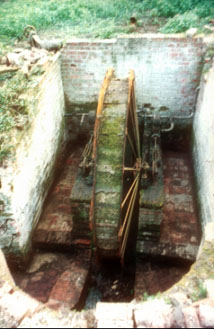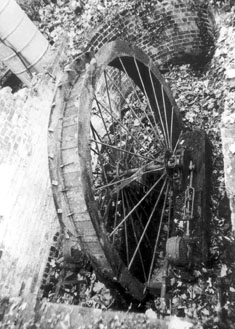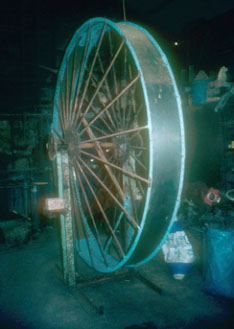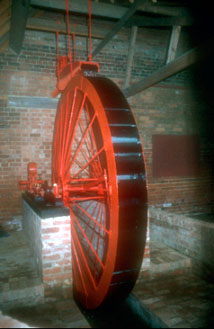Recovery Projects
Milton Keynes Museum Society has undertaken many recovery projects over the years.
The E & H Roberts Waterwheel
One of its first major challenges was the rescue of the E & H Roberts Waterwheel now on show at Milton Keynes Museum.
The wheel was built in about 1890 for use at Wakefield Lodge, Potterspury for the Duke of Grafton by E & H Roberts of Deanshanger, the well-known ironfounders and agricultural engineers.The firm of E & H Roberts produced a prodigious amount of agricultural and domestic items over the years, including waterwheels, windpumps, elevators, carts and wagons. The history of Roberts goes back to 1820 when a foundry was started in the middle of Deanshanger, alongside the Buckingham arm of the Grand Union canal. The firm went into liquidation during the depression in 1927.


The waterwheel in situ at Wakefield Lodge before restoration
The waterwheel from Wakefield Lodge was situated between two lakes, and operated by water fed by a cast iron pipe leading to the launder over the wheel, and controlled by a valve. The water flowed over the waterwheel, fell to the bottom of a brick pit and then flowed out through an eight inch (204mm) salt-glazed pipe into a ditch that fed the smaller lake.
On either side of the waterwheel, pumps were mounted and driven by crank rods. These pumped water from a nearby well to feed Wakefield Lodge and a complex of smaller houses and buildings with a water supply. The wheel was removed by a team from Stacey Hill Society in the early 1970s and involved much work in clearing the site and then in the actual recovery.


The waterwheel being restored and then operational at the Museum.
The wheel was taken to a Society member’s workshop and stood on a specially made cradle. It was in very poor condition. All the side plates, bottom plates and paddles were almost rusted away. The side and bottom plates had been riveted to an angle framework with 656 5/16 inch (8mm) rivets, the paddles with 320 1/4 inch (6mm) rivets and a further 206 1/4 inch (6mm) rivets held jointing plates in position. This meant the cutting out with the electric welder of every single rivet and its replacement by hand – a total of 1,182 rivets! A special cradle had to be made to hold the riveting dolly in place.
The Roberts waterwheel is just one example of many recovery projects that the Stacey Hill Society has undertaken over the years.
Today the waterwheel can be seen operating at Milton Keynes Museum as part of a large collection of displayed items produced by E & H Roberts.
